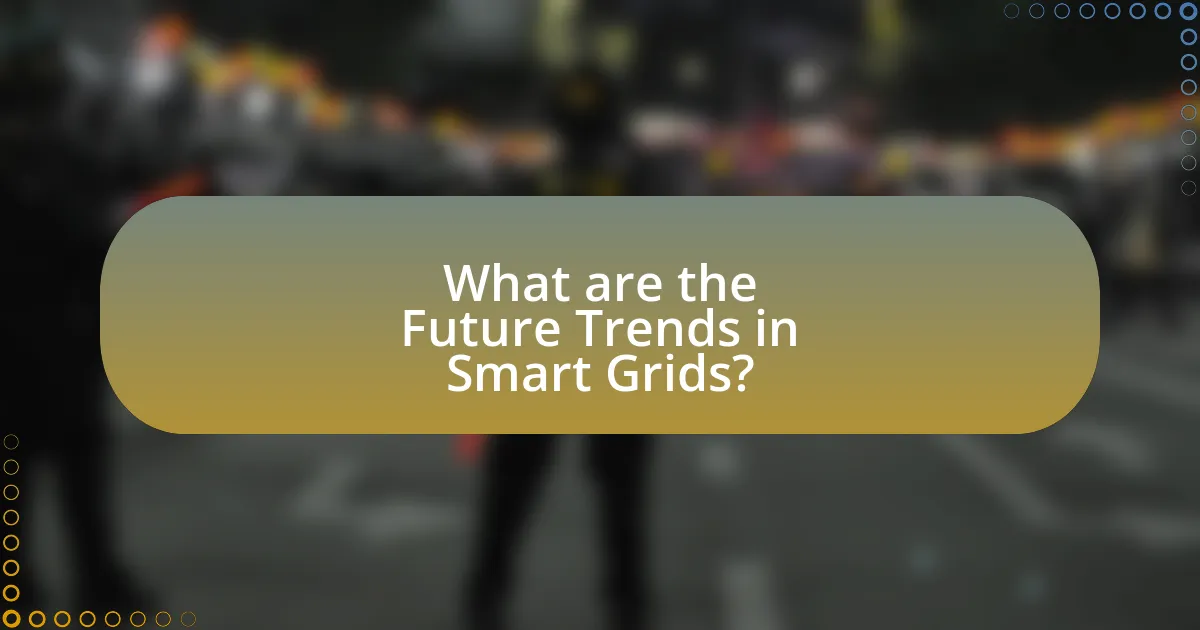Smart grids are advanced electrical systems that utilize digital technology to enhance the efficiency, reliability, and sustainability of electricity distribution in urban environments. This article explores the critical role of smart grids in urban development, highlighting their ability to integrate renewable energy sources, improve energy efficiency, and reduce greenhouse gas emissions. Key technologies such as advanced metering infrastructure, smart sensors, and data analytics are discussed, along with the environmental benefits and challenges associated with their implementation. Additionally, the article examines future trends, the impact of artificial intelligence, and the importance of stakeholder engagement and policy in successfully adopting smart grid technologies for sustainable urban growth.

What are Smart Grids and Their Role in Urban Development?
Smart grids are advanced electrical grid systems that utilize digital technology to monitor and manage the transport of electricity from all generation sources to meet the varying electricity demands of end users. They play a crucial role in urban development by enhancing energy efficiency, integrating renewable energy sources, and improving the reliability of electricity supply. For instance, smart grids facilitate real-time data collection and analysis, enabling better demand response and reducing energy waste. According to the U.S. Department of Energy, smart grid technologies can reduce energy consumption by up to 20% and significantly lower greenhouse gas emissions, thereby supporting sustainable urban growth.
How do Smart Grids function within urban environments?
Smart grids function within urban environments by integrating advanced communication technologies with traditional electrical grids to enhance efficiency, reliability, and sustainability. These systems utilize real-time data analytics to monitor and manage energy distribution, allowing for better demand response and load balancing. For instance, smart meters provide consumers with detailed usage information, enabling them to adjust their consumption patterns, which can lead to a reduction in peak demand by up to 15%, as reported by the U.S. Department of Energy. Additionally, smart grids facilitate the integration of renewable energy sources, such as solar and wind, into the urban energy mix, promoting a transition towards cleaner energy solutions. This capability is crucial in urban areas where energy consumption is high, and the need for sustainable practices is paramount.
What technologies are integral to Smart Grids?
Smart grids rely on several integral technologies, including advanced metering infrastructure (AMI), smart sensors, communication networks, and distributed energy resources (DER). AMI enables two-way communication between utilities and consumers, facilitating real-time data exchange and improved energy management. Smart sensors monitor grid conditions and performance, enhancing reliability and efficiency. Communication networks, such as fiber optics and wireless technologies, support data transmission across the grid. DER, including solar panels and energy storage systems, allow for localized energy generation and consumption, promoting sustainability. These technologies collectively enhance grid resilience, efficiency, and integration of renewable energy sources, which are essential for sustainable urban development.
How do Smart Grids enhance energy efficiency?
Smart Grids enhance energy efficiency by enabling real-time monitoring and management of energy consumption. This technology allows for dynamic adjustments in energy distribution based on demand, which reduces waste and optimizes resource use. For instance, according to the U.S. Department of Energy, Smart Grids can lead to a 10-30% reduction in energy consumption through improved load balancing and integration of renewable energy sources. Additionally, Smart Grids facilitate demand response programs, encouraging consumers to shift their energy usage to off-peak times, further enhancing overall efficiency.
Why are Smart Grids essential for sustainable urban development?
Smart grids are essential for sustainable urban development because they enhance energy efficiency, integrate renewable energy sources, and improve reliability in urban infrastructure. By utilizing advanced communication and automation technologies, smart grids enable real-time monitoring and management of energy consumption, which leads to reduced waste and lower greenhouse gas emissions. For instance, a study by the International Energy Agency indicates that smart grid technologies can reduce energy consumption by up to 30% in urban areas. Additionally, smart grids facilitate the integration of solar and wind energy, allowing cities to transition to cleaner energy sources, thereby supporting sustainability goals.
What environmental benefits do Smart Grids provide?
Smart Grids provide significant environmental benefits by enhancing energy efficiency and integrating renewable energy sources. They facilitate real-time monitoring and management of energy consumption, which reduces waste and lowers greenhouse gas emissions. For instance, a study by the U.S. Department of Energy indicates that Smart Grids can reduce electricity consumption by up to 15%, leading to a decrease in carbon emissions. Additionally, Smart Grids support the integration of solar and wind energy, allowing for a cleaner energy mix and reducing reliance on fossil fuels. This transition contributes to a more sustainable urban environment by promoting cleaner air and reducing the urban heat island effect.
How do Smart Grids support renewable energy integration?
Smart grids support renewable energy integration by enabling real-time monitoring and management of energy flows, which enhances the efficiency and reliability of electricity distribution. They utilize advanced technologies such as smart meters, sensors, and automated controls to facilitate the incorporation of variable renewable energy sources like solar and wind. For instance, according to the U.S. Department of Energy, smart grid technologies can increase the integration of renewable energy by up to 30% by improving grid flexibility and responsiveness. This capability allows for better demand response and energy storage solutions, ensuring that excess renewable energy can be utilized effectively rather than wasted.

What are the Future Trends in Smart Grids?
Future trends in smart grids include increased integration of renewable energy sources, enhanced energy storage solutions, and the implementation of advanced data analytics for real-time monitoring and management. The shift towards decentralized energy generation, such as solar and wind, is expected to grow, with the International Energy Agency projecting that renewables will account for 80% of global electricity by 2050. Additionally, energy storage technologies, like lithium-ion batteries, are becoming more cost-effective, facilitating better energy management and reliability. The use of artificial intelligence and machine learning in smart grids will enable predictive maintenance and optimize energy distribution, improving efficiency and reducing operational costs. These trends are supported by ongoing investments in smart grid technologies, with the global smart grid market projected to reach $61 billion by 2028, according to a report by Fortune Business Insights.
How is technology evolving in Smart Grid systems?
Technology in Smart Grid systems is evolving through advancements in digital communication, data analytics, and automation. These innovations enable real-time monitoring and management of energy resources, enhancing efficiency and reliability. For instance, the integration of Internet of Things (IoT) devices allows for improved demand response and grid resilience, while machine learning algorithms optimize energy distribution based on consumption patterns. According to the U.S. Department of Energy, investments in Smart Grid technologies have led to a 20% reduction in outage duration and a 30% increase in operational efficiency, demonstrating the tangible benefits of these technological advancements.
What role does artificial intelligence play in Smart Grids?
Artificial intelligence plays a crucial role in Smart Grids by enhancing operational efficiency, optimizing energy distribution, and enabling predictive maintenance. AI algorithms analyze vast amounts of data from various sources, such as smart meters and sensors, to forecast energy demand and supply fluctuations. For instance, a study by the International Energy Agency highlights that AI can improve grid reliability by up to 30% through real-time data analysis and automated decision-making processes. This capability allows for better integration of renewable energy sources, ultimately supporting sustainable urban development initiatives.
How are data analytics transforming Smart Grid operations?
Data analytics are transforming Smart Grid operations by enabling real-time monitoring and optimization of energy distribution. This transformation allows utilities to analyze vast amounts of data from smart meters and sensors, leading to improved demand forecasting and enhanced grid reliability. For instance, a study by the U.S. Department of Energy reported that implementing data analytics in Smart Grids can reduce operational costs by up to 25% and improve energy efficiency by 10-15%. These advancements facilitate better integration of renewable energy sources and support proactive maintenance, ultimately contributing to a more resilient and sustainable energy infrastructure.
What challenges do Smart Grids face in urban settings?
Smart Grids face several challenges in urban settings, including infrastructure integration, cybersecurity risks, and regulatory hurdles. Urban environments often have outdated electrical infrastructure that complicates the integration of advanced Smart Grid technologies, leading to inefficiencies. Additionally, the increased connectivity of Smart Grids makes them vulnerable to cyberattacks; a report from the U.S. Department of Energy highlights that 70% of utilities have experienced cyber incidents. Regulatory challenges arise from the need for updated policies that accommodate new technologies and ensure equitable access to energy resources. These factors collectively hinder the effective implementation and operation of Smart Grids in urban areas.
How can cybersecurity threats impact Smart Grid functionality?
Cybersecurity threats can severely disrupt Smart Grid functionality by compromising data integrity, availability, and system control. For instance, a cyberattack can lead to unauthorized access to critical infrastructure, resulting in power outages or equipment damage. According to the U.S. Department of Energy, a successful cyber intrusion could manipulate grid operations, causing cascading failures across interconnected systems. Additionally, ransomware attacks can lock operators out of essential systems, halting energy distribution and impacting overall grid reliability. These threats highlight the necessity for robust cybersecurity measures to protect Smart Grids from potential vulnerabilities.
What are the financial barriers to implementing Smart Grids?
The financial barriers to implementing Smart Grids include high initial capital costs, ongoing maintenance expenses, and the need for substantial investment in infrastructure upgrades. High initial capital costs can deter utilities and governments from adopting Smart Grid technologies, as estimates suggest that transitioning to Smart Grids may require investments ranging from $1 trillion to $3 trillion globally over the next few decades. Ongoing maintenance expenses further complicate financial feasibility, as utilities must allocate funds for continuous upgrades and cybersecurity measures. Additionally, the need for substantial investment in infrastructure upgrades, such as advanced metering systems and communication networks, poses a significant financial challenge, particularly in regions with limited budgets or competing priorities.

How can Cities Implement Smart Grids Effectively?
Cities can implement smart grids effectively by integrating advanced technologies, enhancing infrastructure, and fostering stakeholder collaboration. The integration of technologies such as IoT devices, data analytics, and renewable energy sources enables real-time monitoring and management of energy consumption. For instance, cities like San Diego have successfully deployed smart meters that provide residents with detailed energy usage data, leading to a 10% reduction in energy consumption.
Enhancing infrastructure involves upgrading existing electrical systems to support two-way communication and distributed energy resources. The city of Amsterdam has invested in smart grid infrastructure that allows for better integration of solar panels and electric vehicles, resulting in increased energy efficiency and reduced carbon emissions.
Fostering collaboration among government agencies, utility companies, and the community is crucial for successful implementation. In Barcelona, public-private partnerships have facilitated the development of smart grid projects, ensuring that diverse perspectives and resources are utilized effectively. This collaborative approach has led to innovative solutions that address local energy challenges while promoting sustainability.
What best practices should cities follow for Smart Grid deployment?
Cities should prioritize stakeholder engagement and collaboration for effective Smart Grid deployment. Engaging utility companies, government agencies, and community members ensures that diverse perspectives are considered, leading to more comprehensive planning and implementation. Additionally, cities should invest in robust infrastructure and technology that supports interoperability and scalability, allowing for future upgrades and integration with renewable energy sources. Data privacy and cybersecurity measures must also be established to protect sensitive information and maintain public trust. According to the U.S. Department of Energy, successful Smart Grid initiatives have demonstrated that these practices lead to enhanced reliability, efficiency, and sustainability in urban energy systems.
How can stakeholder engagement improve Smart Grid initiatives?
Stakeholder engagement can significantly improve Smart Grid initiatives by fostering collaboration and ensuring that diverse perspectives are considered in the planning and implementation processes. Engaging stakeholders, including utility companies, government agencies, consumers, and community organizations, leads to better alignment of Smart Grid technologies with local needs and priorities. For instance, a study by the U.S. Department of Energy found that projects with active stakeholder involvement are 30% more likely to meet their objectives and achieve user satisfaction. This collaborative approach not only enhances the design and functionality of Smart Grids but also builds trust and encourages broader acceptance among users, ultimately leading to more successful and sustainable urban development outcomes.
What role does policy play in Smart Grid implementation?
Policy plays a crucial role in Smart Grid implementation by establishing regulatory frameworks that facilitate investment, innovation, and integration of renewable energy sources. Effective policies promote the development of standards and interoperability, ensuring that various technologies can work together seamlessly. For instance, the U.S. Department of Energy’s Smart Grid Investment Grant program allocated $4.5 billion to support Smart Grid projects, demonstrating how government funding can accelerate deployment and enhance grid reliability. Additionally, policies that incentivize energy efficiency and demand response programs encourage consumer participation, which is essential for optimizing grid performance and reducing peak demand.
What are the potential impacts of Smart Grids on urban life?
Smart Grids significantly enhance urban life by improving energy efficiency, reliability, and sustainability. They enable real-time monitoring and management of energy consumption, which leads to reduced energy waste and lower utility costs for residents. According to the U.S. Department of Energy, Smart Grids can reduce energy consumption by up to 15% through demand response programs and better load management. Additionally, they facilitate the integration of renewable energy sources, such as solar and wind, into the urban energy mix, promoting cleaner energy usage. This transition not only decreases greenhouse gas emissions but also supports urban resilience against climate change impacts. Furthermore, Smart Grids enhance the reliability of electricity supply, reducing outages and improving overall quality of life in urban areas.
How can Smart Grids improve public services in cities?
Smart Grids can improve public services in cities by enhancing the efficiency and reliability of energy distribution. These advanced systems utilize real-time data and communication technologies to optimize energy use, reduce outages, and integrate renewable energy sources. For instance, a study by the U.S. Department of Energy reported that Smart Grids can reduce energy losses by up to 30%, leading to lower operational costs for public services. Additionally, Smart Grids facilitate better demand response management, allowing cities to adjust energy supply based on real-time consumption patterns, which can improve the overall quality of services such as public transportation and street lighting.
What are the social implications of Smart Grid technology?
Smart Grid technology has significant social implications, primarily enhancing energy accessibility and promoting community engagement. By integrating advanced communication and automation technologies, Smart Grids facilitate real-time energy management, which can lead to reduced energy costs for consumers and improved reliability of energy supply. This technology empowers users to monitor and control their energy consumption, fostering a culture of energy efficiency and sustainability.
Moreover, Smart Grids can enhance social equity by providing underserved communities with better access to renewable energy sources and energy-saving programs. For instance, studies have shown that Smart Grid implementations can lead to a 10-15% reduction in energy bills for low-income households, thereby alleviating energy poverty. Additionally, the participatory nature of Smart Grids encourages local stakeholders to engage in energy decision-making processes, strengthening community ties and promoting collective action towards sustainability goals.
What practical steps can cities take to adopt Smart Grids?
Cities can adopt Smart Grids by implementing advanced metering infrastructure, integrating renewable energy sources, and enhancing data analytics capabilities. Advanced metering infrastructure allows for real-time monitoring and management of energy consumption, which improves efficiency and reduces costs. Integrating renewable energy sources, such as solar and wind, enables cities to diversify their energy supply and decrease reliance on fossil fuels, contributing to sustainability goals. Enhancing data analytics capabilities allows for better decision-making and optimization of energy distribution, as evidenced by cities like San Diego, which reported a 20% reduction in energy costs after adopting Smart Grid technologies.
How can cities assess their readiness for Smart Grid technology?
Cities can assess their readiness for Smart Grid technology by conducting a comprehensive evaluation of their existing infrastructure, regulatory frameworks, and stakeholder engagement. This assessment involves analyzing current energy consumption patterns, grid reliability, and the integration of renewable energy sources. For instance, cities can utilize tools like the Smart Grid Maturity Model, which provides a structured approach to evaluate capabilities across various dimensions such as technology, operations, and customer engagement. Additionally, cities should engage with local utilities, government agencies, and community stakeholders to gather insights and foster collaboration. This collaborative approach ensures that the assessment reflects the unique needs and challenges of the community, ultimately guiding effective planning and implementation of Smart Grid initiatives.
What funding options are available for Smart Grid projects?
Funding options for Smart Grid projects include government grants, private investments, public-private partnerships, and utility funding programs. Government grants, such as those from the U.S. Department of Energy, provide financial support specifically for innovative energy technologies, including Smart Grids. Private investments often come from venture capital firms looking to support emerging technologies in the energy sector. Public-private partnerships leverage resources from both sectors to finance large-scale Smart Grid initiatives. Utility funding programs, often mandated by regulatory bodies, allocate funds for infrastructure improvements that enhance grid reliability and efficiency. These funding sources collectively support the development and implementation of Smart Grid technologies, facilitating advancements in sustainable urban development.


